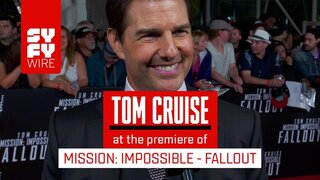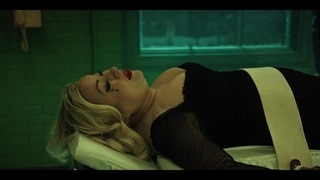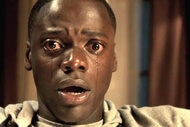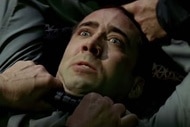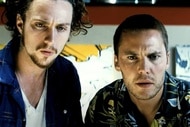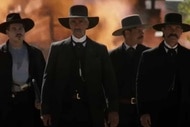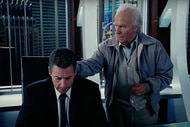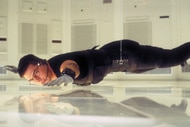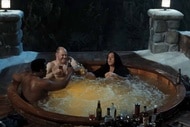Create a free profile to get unlimited access to exclusive videos, sweepstakes, and more!
The First 3 Mission: Impossible Movies Still Make for a Darn Good Trilogy
Ethan Hunt's adventures continue on, but the first three Mission: Impossible movies still form a solid trilogy.
It's been nearly 30 years since Tom Cruise first played Ethan Hunt, and the Mission: Impossible movie franchise is still not finished. A new film is on the way in the near future, we have no idea where the endgame lies, and Cruise himself seems more determined than ever to craft astonishing stunt setpieces as often as possible with the M:I franchise as a launchpad.
But the series didn't always feel as enduring as it does now. There were long gaps between the release of the second and third films (six years), and the third and fourth films (five years), which meant that for a time it was possible that a trilogy was all we'd get, leaving Ethan to ride off into the sunset at the end of 2006's Mission: Impossible III. That didn't happen, of course, but looking back at those first three films and their 10-year story of Hunt and those closest to him, it feels like if things had wrapped up after a trilogy, we would've still been left with something satisfying, thrilling, and even occasionally poignant.
For More on Mission: Impossible:
All the Mission: Impossible Movies, Ranked
Why the First Mission: Impossible Movie Still Holds Up
Why You Should Give Mission: Impossible III A Second Chance
Why the First Three Mission: Impossible Movies Still Hold Up
Three Directors, Three Visions
Mission: Impossible is Cruise's franchise. That's inarguable at this point, as he's worked as both star and producer since the films began and has significant input on how the films unfold, working in conjunction with current franchise writer/director Christopher McQuarrie. In some ways it was always Cruise's franchise, but one of the hallmarks of the first three films in particular are their visual and stylistic distinctions courtesy of three different directors. Watching them back to back to back, it always feel like Ethan Hunt's story, but it also feels like he's progressing through three distinct eras with the aid of three talented filmmakers, including two absolute legends in their fields.
With Mission: Impossible in 1996, we got all the methodical, stylish intensity that comes from a Brian De Palma film, as the legendary director built up Hitchcockian tension around setpieces and characters and infused his own distinct sense of color and perspective into the story. Then came Mission: Impossible II in 2000, and the all-out frenzy of Hong Kong stylist John Woo. Bringing in a director like Woo for the turn-of-the-millennium installment of the series certainly seems fitting, as he'd spent the '90s establishing himself as an English-language action director after years of work in Hong Kong, and with Cruise seemingly game for any stunt he could muster, Woo clearly just went for it. M:I 2 doesn't always hold together that well, and storywise it might be the weakest in the series, but when Woo is able to ramp up to the full-on balletic action for which he's known, it's a blast.
Which brings us to Mission: Impossible III, and the feature directorial debut of J.J. Abrams. With the third M:I, Abrams brought all the fast-paced, twist-laden stylistic flare (pun intended) that he brought to his spy TV series, Alias, and while his visual stamp is certainly on the film, what he did with the story is the bigger contribution. Both previous M:I installments dealt with death and destruction, to be sure, but they were also popcorn thrillers determined to wring the maximum amount of fun out of the audience. By contrast, M:I 3 opens with Hunt believing that the woman he loves has just been shot in the head, then flashbacks to their happy life together. That structural shift, along with the twists in the plot itself, is a classic Abrams move, particularly from back in the days of Alias and Lost, and it's something that would carry through to the subsequent films in the franchise. Mission: Impossible always had twists, to be sure, but after its third film, the ante was forever upped.
Ethan Hunt's Journey in the First Three Mission: Impossible Movies
Though they certainly have their share of disparate elements –– the action star Ethan Hunt of the second film is not the careful spy of the first –– there is of course a connecting thread through these films: Cruise as Hunt. It's a character he clearly feels responsibility for now, but even back in the earlier days of the franchise, he was working hard to craft a guy we could root for who was nonetheless at least somewhat complex.
That meant that each of these films had to add something to Ethan, had to build on what came before to create a character who was growing and changing even if his job, and the kinds of movies he was starring in, hadn't changed much. Believe it or not, despite their stylistic swings, the first three films work in concert to deliver exactly that.
In Mission: Impossible, Ethan is the determined, loyal public servant who quickly finds himself betrayed by those he once trusted when an operation goes wrong and he's framed for the fallout. The object of a plot like this, which begins with Ethan's team being wiped out by other operatives, was to turn the original Mission: Impossible TV show dynamic on its head to surprise the audience. It certainly does that, but it also gives us an Ethan Hunt who emerges as a kind of stock hero who has to make tougher, more nuanced choices when he's knocked back on his heels. This gives us the customary maverick (again, pun intended) nature of the character that we now know quite well, and it also gives us another key ingredient: Ethan's willingness to rely on people who are more like his family than his coworkers, a select inner circle that will evolve with the films to come.
In M:I 2, Ethan's past betrayal has clearly made an impact on him. Woo, ever the stylist, leans into Ethan's sense of distrust of the larger structures in which he works, giving the character longer hair and a leather jacket, not to mention a motorcycle chase to cap it all off, in a film that sees Ethan playing by his own rules even while completing most of the mission he's assigned. In the first film, he's a spy who must save himself and those around him. In the second, he's a superhero who can forge his own path no matter what those around him say.
But every superhero needs a weakness, which brings us to Mission: Impossible III, a story that gives Ethan a chance at a life beyond missions. He's stepped out of the field and become an instructor, gotten engaged to a woman he loves (Michelle Monaghan), and done his best to live a quieter life. But those personal attachments that pulled him through the first two missions start to gnaw at him when an operative he trained goes missing, setting him on a collision course with a ruthless and terrifying arms dealer (Philip Seymour Hoffman, still the best villain of the series). It's there that the personal and the professional collide for Ethan in ways they never have before, leaving him with a choice to make about the kind of man he wants to be going forward, a choice that will carry through to future installments in the series.
This clear arc, fragmented though it may be by the various detours in the franchise, means that the first tree M:I films represent a successful trilogy in the same way that the McQuarrie era represents a successful new arc for Ethan Hunt, and Brad Bird's Mission: Impossible - Ghost Protocol represents a successful bridge between the two. If you want to see how the Ethan Hunt of then became the Ethan Hunt of now, watch these films as close together as possible, and see the connective tissue.
Mission: Impossible 1-4 are now streaming on Peacock.

